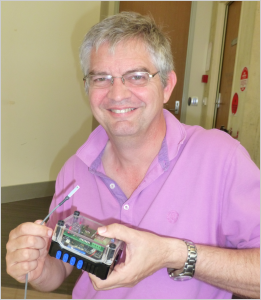Mar 14 2014
A wireless network of sensors that is set to revolutionise soil-based salinity measuring is being developed by a University of Southampton researcher and a team of Australian academics.
 Dr Nick Harris
Dr Nick Harris
Dr Nick Harris, from Electronics and Electrical Engineering, worked with a group of professors from the University of Western Australia (UWA) to produce the revolutionary sensor that can carry out non-destructive testing of soil samples.
The sensor is capable of measuring the chloride (salt) in the soil moisture and linking up with other sensors to create a wireless network that can collate and relay the measurement readings. The network can also control the time intervals at which measurements are taken.
The sensor is placed in the soil and measures the chloride levels in the soil moisture in a non-destructive way. These chloride levels make up a high proportion of the overall soil salinity.
“Traditionally soil-based measurements involve taking samples and transporting them to the laboratory for analysis,” said Nick. “This is very labour and cost intensive and therefore it usually means spot checks only with samples being taken every two to three months. It also doesn’t differentiate between chloride in crystallised form and chloride in dissolved form. This can be an important difference as plants only ‘see’ chloride in the soil moisture.
“The removal of a soil sample from its natural environment also means that the same sample can only be measured once, so the traditional (destructive) method is not suited to measuring changes at a point over a period of time.”
The new sensors are connected to a small unit and can be ‘planted’ in the ground and left to their own devices. The limiting factor for lifetime is usually the sensor. However, these sensors are expected to have a lifetime in excess of one year. The battery-powered unit can transmit data and information by short range radio, Bluetooth, satellite or mobile phone network as well as allowing data to be logged to a memory card to be collected later.
The novel device allows up to seven sensors to be connected at a time to a single transmitter allowing multi-point measurements to be simply taken.
“These soil-based chloride sensors can benefit a wide range of applications. Large parts of the world have problems with salt causing agricultural land to be unusable but the new sensors allow the level of salt to be measured in real time, rather than once every few months as was previously the case,” said Nick.
“At plant level probes can be positioned at continuous levels of depth to determine the salt concentration to which roots are exposed and whether this concentration changes with the depth of the soil or in different weather conditions. We can also measure how well a plant performs at a particular concentration and change the salt content for a few days and observe the effects.
“On a bigger scale, sensors could be placed at different locations at catchment scale to observe any changes in the level of salinity within a field over time, having a direct impact on irrigation strategies. We have already been able to make some interesting observations on real world chloride concentration changes over just 24 hour periods, illustrating the dangers of relying on single point, single time measurements,” added Nick.
Nick’s sabbatical at UWA was supported with £2,000 of funding from the World University Network with the sensor development work supported by the Biotechnology and Biological Sciences Research Council.
He worked on the research project with Dr Andy Cranny, in ECS; and professors Keith Smettem, Neil Coles, Ed Barrett-Lennard and Mark Rivers from UWA.